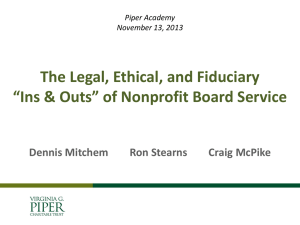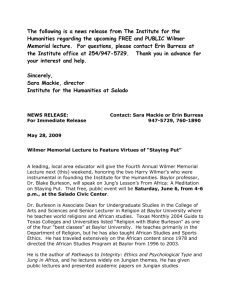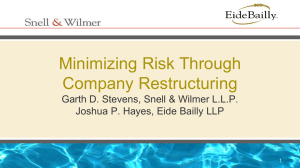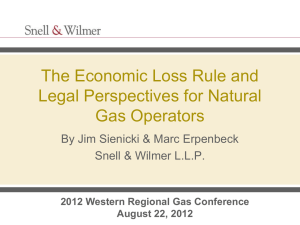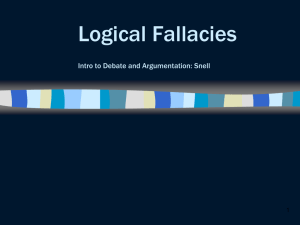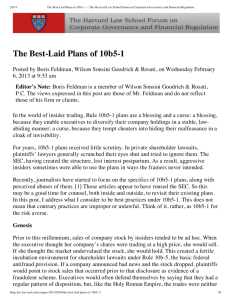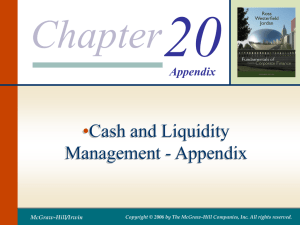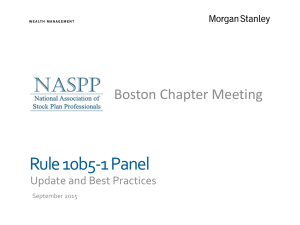10b5-1 Plans Presentation
advertisement
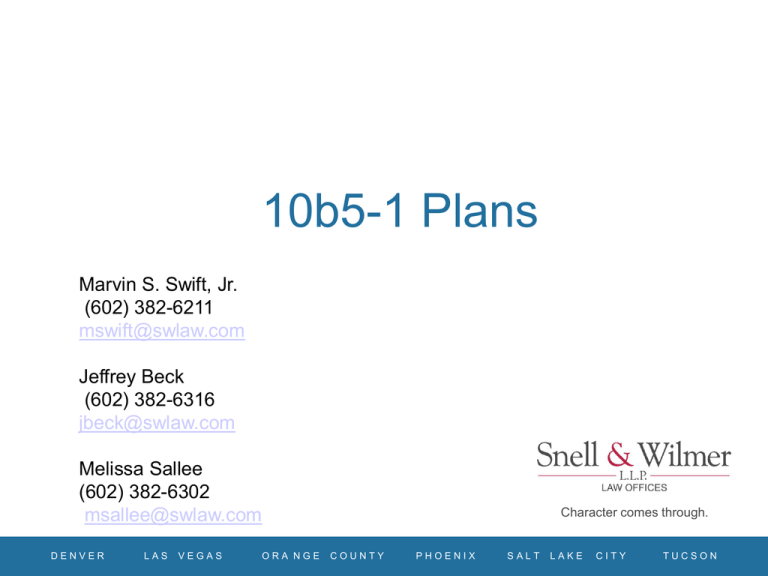
10b5-1 Plans Marvin S. Swift, Jr. (602) 382-6211 mswift@swlaw.com Jeffrey Beck (602) 382-6316 jbeck@swlaw.com Melissa Sallee (602) 382-6302 msallee@swlaw.com DENVER LAS VEGAS ORA NGE Character comes through. COUNTY PHOENIX SALT LAKE CITY TUCSON Rule 10b-5 Insider Trading Liability Employment of Manipulative and Deceptive Devices SEC Rule 10b-5 prohibits any person, directly or indirectly, by the use of any means or instrumentality of interstate commerce, or of the mails, or of any facility of any national securities exchange, in connection with the purchase or sale of any security: • To employ any device, scheme, or artifice to defraud; • To make any untrue statement of a material fact or to omit to state a material fact necessary in order to make the statements made, in the light of the circumstances under which they were made, not misleading; or • To engage in any act, practice, or course of business which operates or would operate as a fraud or deceit upon any person. ©2005 Snell & Wilmer L.L.P. 2 Rule 10b5-1 Implements the Manipulative and Deceptive Devices Standard The Rule prohibits, among other things, the purchase or sale of a security of any issuer “on the basis of” material nonpublic information about the security or the issuer. What does “on the basis of” mean in connection with the purchase or sale of a security? • Is proof required that the person “used” material nonpublic information in connection with purchase or sale? • Is it enough to prove that the person “knowingly possessed” material nonpublic information at the time of the trade. ©2005 Snell & Wilmer L.L.P. 3 Courts Have Split on the Applicable Standard • Second Circuit in U.S. v. Teicher suggested that “knowing possession” is sufficient to trigger insider trading liability. • Eleventh Circuit in SEC v. Adler held that “use” was the ultimate issue, but that proof of “knowing possession” provides a strong inference of use that suffice to make out a prima facie case. • Ninth Circuit in U.S. v. Smith requires that “use” be proven in a criminal case. ©2005 Snell & Wilmer L.L.P. 4 Rule 10b5-1(b) Implements a “Knowing Possession” Standard • A person is deemed to have purchased or sold a security “on the basis of” material nonpublic information if the person was aware of the information when making the purchase or sale. • From the SEC’s view, if the person is aware of the material nonpublic information, the person will inevitably make use of the information. • A person can be “aware of” the information from surrounding circumstances or from circumstantial evidence and the person can’t successfully argue that his or her knowing the information had no impact on his or her decision to trade. ©2005 Snell & Wilmer L.L.P. 5 Affirmative Defenses Rule 10b5-1(c) sets forth two separate affirmative defenses: 1. If the trade was made under a binding contract, trading instruction, or written plan that came into existence before the person became aware of the material nonpublic information (applies to natural persons and entities). 2. If the entity was not aware of any material nonpublic information and implemented reasonable policies and procedures to ensure the person making the trade would not violate the insider trading laws (applies only to entities). ©2005 Snell & Wilmer L.L.P. 6 Rule 10b5-1 Plans • Designed to provide insiders flexibility to plan future transactions, at a time when they are not aware of material nonpublic information so that the future transaction(s) can occur - even if the insider has material nonpublic information at the time of the transaction(s). • The Plan must be entered into in good faith and not part of a scheme to evade the 10b5-1 rules. ©2005 Snell & Wilmer L.L.P. 7 Requirements of a 10b5-1 Plan Before coming aware of the material nonpublic information, the person must have: • Entered into a binding contract to buy or sell the security; • Instructed another person to buy or sell the security for their account; or • Adopted a written plan for trading securities. ©2005 Snell & Wilmer L.L.P. 8 Requirements of a 10b5-1 Plan (cont’d) The contract, instruction, or plan must: • Specify the amount of the securities to be purchased or sold, the price at which and the date on which the securities are to be purchased or sold; • Include a written formula, algorithm, or computer program for determining the amount of the securities to be purchased or sold, the price at which and the date on which the securities are to be purchased or sold; or • Prohibit the person from exercising any subsequent influence over how, when and whether to effect the purchase or sale. ©2005 Snell & Wilmer L.L.P. 9 Requirements of a 10b5-1 Plan (cont’d) The purchase or sale must occur pursuant to the contract, instruction or plan. • The purchase or sale is not pursuant to the contract, instruction or plan if the person who established it altered or deviated from the contract, instruction or plan or entered into or altered a corresponding or hedging transaction or positions with respect to the securities. ©2005 Snell & Wilmer L.L.P. 10 Amount, Price and Date Defined • The Amount must either be a specified number of shares or specified value of shares. • The Price means the market price on a particular date or a limit price, or a particular dollar price. • Date means in the case of a market order, the specific day of the year on which the order is to be executed and in the case of a limit order, the date of the year on which the limit order is in force. ©2005 Snell & Wilmer L.L.P. 11 Other Issues and Considerations • Best practice is to establish the trading plan during an open trading window. • The program should either specify precisely how determinations as to amounts, prices, dates and frequency of transactions are to be made, or delegate responsibility to a party not subject to the influence of the person who established the program nor is in privy to nonpublic information. • The program should specify a termination date. • The program should make allowances for unforeseen circumstances that would warrant automatic cancellation of the program (e.g., announcement of a merger, Regulation M, underwriting lockup, etc.). ©2005 Snell & Wilmer L.L.P. 12 Other Issues and Considerations (cont’d) • Need to take into account other notification requirements, for example Rule 144 and Section 16 (Form 4’s). • Frequent modifications are not advisable and any modification needs to be made when not in possession of material inside information. • Terminations are tricky – generally there is no requirement to sell, so presumably the plan can be cancelled at any time. ► Warning – cancelling a plan raises serious questions about the good faith intentions so persons are advised to wait a substantial period (between 6 and 12 months) after the unscheduled termination of a plan to enter into any subsequent plans. ► Emerging Issue – what is the impact if an insider causes a company to delay or accelerate the release of material information with knowledge a future transaction will benefit from such release, or delay? ©2005 Snell & Wilmer L.L.P. 13 Other Issues and Considerations (cont’d) • Many companies publicly announce trading plans established by senior executive officers and directors. • Many commentators believe a period of at least 30 days should elapse between the time a plan is entered into and the time the first trade is scheduled to occur. • Rule 144 filing issue can be tricky since the Form must be filed prior to the transaction – consult with your lawyer and broker on the best way to navigate this requirement. ©2005 Snell & Wilmer L.L.P. 14 Litigation Focusing on 10b-5 Plans Countrywide Financial (2009) • SEC filed complaint against the former CEO of Countrywide Financial, Angelo Mozilo, alleging that he used Rule 10b5-1 plans to trade illegally on inside information. • SEC alleged that Mr. Mozillo had material nonpublic information about Countrywide’s deteriorating mortgage business when he instituted his trading plans. • Mr. Mozillo implemented no fewer than four separate plans during a three- month period and sales under the plan began soon after their adoption. • Mr. Mozillo amended one of his Rule 10b5-1 Plans two months after adopting it and “actively amended and modified” his 10b5-1 Plans. ©2005 Snell & Wilmer L.L.P. 15 Litigation Focusing on 10b-5 Plans (cont’d) Backe v. Novatel Wireless, Inc. (2009) • California federal court refused to dismiss a lawsuit against a company’s officers based partly on allegations that they amended their 10b5-1 Plans to sell more stock before the market learned of a significant business development. • Judge commented that the pattern of the officers’ sales “does not square with a typical 10b5-1 plan triggering stock sales on certain dates and at certain prices,” noting that the executives sold varying amounts of stock just before the adverse development became public and on varying dates. ©2005 Snell & Wilmer L.L.P. 16 SEC Guidance SEC has provided guidance about Rule 10b5-1 plans in its Compliance and Disclosure Interpretations • A person may not rely on the Rule when he or she institutes a trading plan while aware of material nonpublic information, even if the plan is structured to delay all transactions until after the information becomes public. • The Rule’s affirmative defense is available only for plans that are entered into in good faith and not as part of a “plan or scheme to evade” insider trading laws. The SEC has stated that this requirement will be assessed in light of all relevant facts, specifically including the time period between canceling one trading plan and establishing a new one. • A corporate insider may transfer a long-standing Rule 10b5-1 Plan to a new broker, if the broker that has been executing the plan’s transactions goes out of business—even if the insider knows of material nonpublic information at the time of the transfer. The transfer must be timed to avoid any cancellation of transactions under the plan, however, and the new broker must observe the plan’s original terms. ©2005 Snell & Wilmer L.L.P. 17
